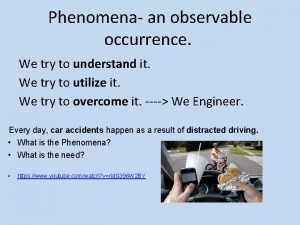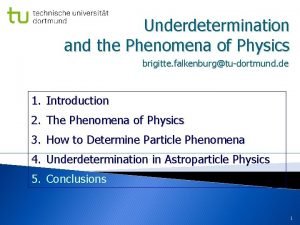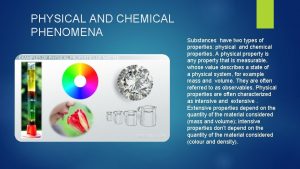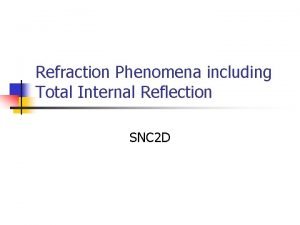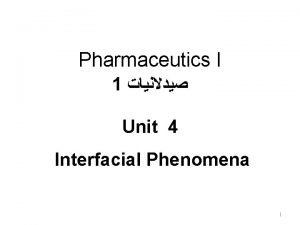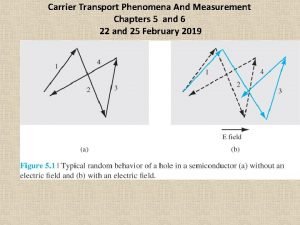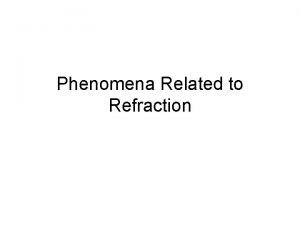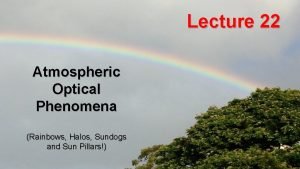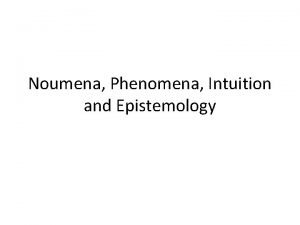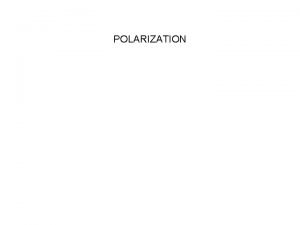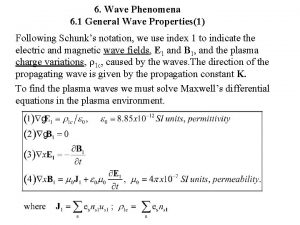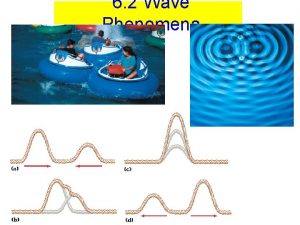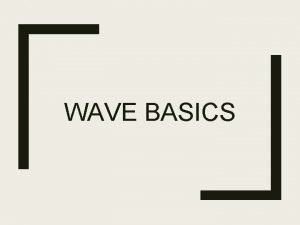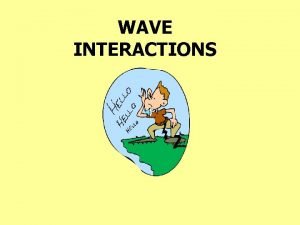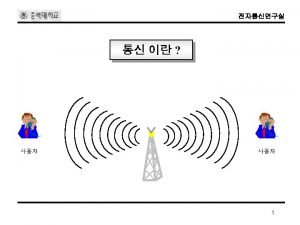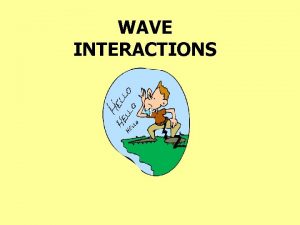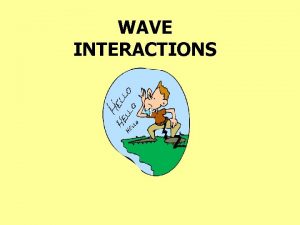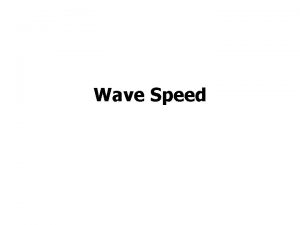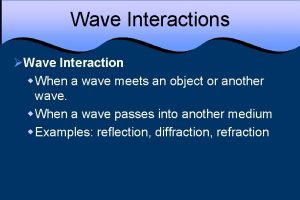11 Wave Phenomena 11 5 Polarization Polarization When


































- Slides: 34

11: Wave Phenomena 11. 5 Polarization

Polarization When a charged particle loses energy, a tiny disturbance or ripple in the surrounding electromagnetic field is created – an e-m wave. electron Electromagnetic waves The wave will be in the same plane as the plane of movement of the particle. If all the disturbances in a ray of light were occurring in the same plane, the light is said to be plane polarised. In reality most sources of light produce unpolarised light because the electrons in the source move in all directions.

Polaroids A Polaroid filter (a polariser) polarises light rays. If an unpolarised ray of light passes through the filter, about 50% of its energy will be absorbed and 50% pass through. Planes before: Plane after:


The original light waves exist in many different planes. The polarising filter only allows components of the wave in one plane to pass through. E. g. - One wave in its original plane: - This has vertical and horizontal components: - Wave after passing through filter with a vertical plane of polarisation (horizontal component absorbed):

Polarisation by Reflection When an unpolarised ray of light is reflected off a non metallic surface, the reflected ray becomes partly polarised. E. g. Reflections of light from cars, the sea etc. The degree of polarisation is dependant upon the angle of incidence of the light.

Brewster’s Angle When light reflects off water, polarisation will be 100% when the angle of incidence is equal to Brewster’s angle (ϕ – phi). This occurs when the angle between the reflected and refracted rays is 90°. ϕ ϕ r


On the right hand side of the normal: ϕ+r = 90 but. . . n = sin i sin r so. . . n = but. . . sin (90 – ϕ) = cos ϕ sin (90 – ϕ) n = sin ϕ = tan ϕ cos ϕ so Brewster’s angle is given by. . . ϕ = tan-1 n

E. g. Calculate Brewster’s angle for diamond (n = 2. 4). ϕ = 67°

Malus’ Law Polarised light of intensity I 0 can be split into two parallel components which in turn may be polarised by a second polarising filter (called an analyser). The resulting intensity (I) is given by Malus’ Law: I = I 0 cos 2 θ Intensity I 0 θ = angle of rotation between the two polarisers. Intensity I I = intensity, the power per unit area (Wm-2)

E. g. A sheet of Polaroid is used to reduce the intensity of a beam of polarised light. What angle should the transmission axis of the Polaroid make with the plane of polarisation of the beam in order to reduce the intensity of the beam by 50%? so. . . I and I ½ I 0 ½ cos 2 θ θ θ = ½ I 0 = I 0 cos 2 θ = √(0. 5) = cos-1 √(0. 5) = 45°


Subtitle Text

Subtitle Text

Subtitle Text

Subtitle Text

Subtitle Text

Subtitle Text

Subtitle Text

Subtitle Text

Subtitle Text

Subtitle Text

Subtitle Text

Subtitle Text

Subtitle Text

Subtitle Text

Subtitle Text

Subtitle Text

Subtitle Text

Subtitle Text

Subtitle Text

Subtitle Text

Subtitle Text
 Rectified sine wave fourier series
Rectified sine wave fourier series Light is an electromagnetic wave true or false
Light is an electromagnetic wave true or false Electromagnetic and mechanical waves
Electromagnetic and mechanical waves Half full wave rectifier
Half full wave rectifier A ____ is a repeating disturbance or movement that
A ____ is a repeating disturbance or movement that Carbon dioxide temperature
Carbon dioxide temperature Example of a mechanical wave
Example of a mechanical wave Center tapped full wave rectifier vs bridge rectifier
Center tapped full wave rectifier vs bridge rectifier The nature of waves chapter 10 section 1
The nature of waves chapter 10 section 1 Difference between full wave and half wave rectifier
Difference between full wave and half wave rectifier Velocity frequency wavelength triangle
Velocity frequency wavelength triangle P and s wave chart
P and s wave chart Fourier series of non periodic function
Fourier series of non periodic function Longitudinal vs transverse waves
Longitudinal vs transverse waves Passer-by monikko
Passer-by monikko Noumena vs phenomena
Noumena vs phenomena Observable phenomenon
Observable phenomenon Contemporary phenomenon examples
Contemporary phenomenon examples What is the meaning of phenomena
What is the meaning of phenomena Is gravity a natural phenomenon
Is gravity a natural phenomenon Physical and chemical phenomena
Physical and chemical phenomena Total internal reflection
Total internal reflection Surface and interfacial phenomena
Surface and interfacial phenomena Random phenomena
Random phenomena Natural language processing
Natural language processing Slidetodoc downloader
Slidetodoc downloader Carrier transport phenomena
Carrier transport phenomena Phenomena related to refraction
Phenomena related to refraction A rainbow is an optical display of color
A rainbow is an optical display of color Reoulox phenomena
Reoulox phenomena Phenomena vs noumena
Phenomena vs noumena Reference phenomena in nlp
Reference phenomena in nlp Noumena vs phenomena
Noumena vs phenomena Anchor phenomenon
Anchor phenomenon Observable phenomena psychology
Observable phenomena psychology
















